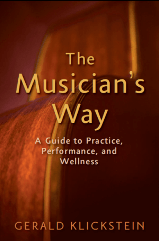“If your programming ideas aren’t working, don’t blame your audiences.”
The Musician’s Way, p. 212
For aspiring musicians, career sustainability depends on audience growth.
Problem is, a standard conservatory education doesn’t equip graduates with the know-how to drive such growth. Students learn to play or sing effectively but not how to put on concerts that attract large, diverse audiences.
To help fill that and other educational gaps, MusiciansWay.com offers a vast array of resources for emerging artists.
This article brings together, under five headings, selected posts from The Musician’s Way Blog that explore ways to create successful concerts and amass loyal listeners.
1. Study the Performing Arts Landscape
Before delving into the specifics of creating concerts, learn about the performing arts industry, study what innovative performers and arts organizations do (e.g., pianist Lara Downes, pictured above), think about the audiences you’d like to reach – including historically underserved people – and generate a vision for how you might form your artistic identity and musical community.
These articles will deepen your knowledge and jump-start your thinking:
- Supply and Demand for Classical Musicians
- Motivations & Barriers to Arts Attendance
- Competitive Advantages
2. Design Distinctive Programs & Experiences
Once you determine the audiences you want to attract, gain insight into their interests, communities, and arts consumption habits. Next, start designing concert programs that align your repertoire with things that your audiences care about. At the same time, consider what sorts of concert experiences would appeal to your listeners, whether innovative, casual, interactive, or traditional. Here’s are some ways to do so:
- The 5 C’s of Concert Planning and Production
- 3 Traits of Successful Concert Programs
- Design Thinking for Audience Development
- Programs that Pop
3. Bring in Funding
Musicians often feel constrained by limited funds. In fact, funds are abundantly available to musicians with cogent plans for impacting new and underserved audiences. In other words, funding follows innovative ideas. These articles will help you spawn compelling ideas and acquire fundraising skills:
- The Funding-First Grant Cycle
- How to Write a Grant Proposal – A Concise Guide
- Resources for Grantseekers
- Commissioning and Funding New Music
4. Partner Strategically
Seek out like-minded organizations whose audiences overlap with yours. Then, explore ways you can benefit each other.
- Partnering with Non-Profits
- Boost Income and Impact with Local Sponsorships
- 3 Ways to Boost the Impact of a Concert
5. Deliver Memorable Shows
Develop your on-stage style and concert experiences so that they’re personally authentic and also engaging to a wide range of listeners. In general, avoid mimicking the detached, overly formal presentation style that’s modeled in conservatories.
- 3 Elements of Showmanship
- Speaking from the Stage
- Connecting with Audiences
- 6 Steps to Better Program Notes
* * *
Bear in mind that it takes time and effort to assimilate the concepts encapsulated here, and they can’t be mastered in isolation.
So, as you refine your ideas and abilities, try out prototypes of concert programs and experiences, and then seek feedback from your audiences, peers and mentors.
All the while, go forward in a spirit of adventure and experimentation because that’s the essence of living The Musician’s Way.
For more articles geared to independent musicians, browse the Entrepreneurship category.
© 2023 Gerald Klickstein
Photo via LaraDownes.com


